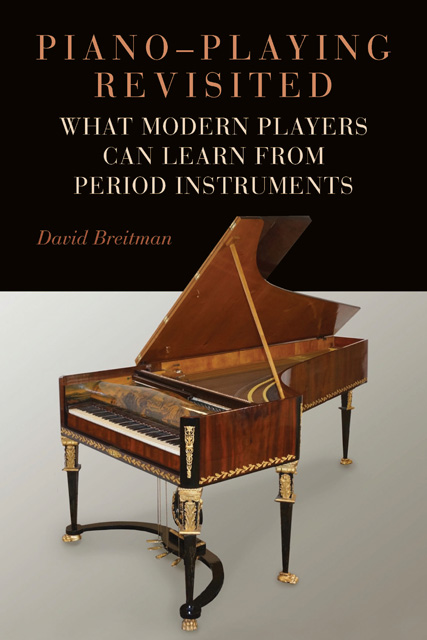Book contents
- Frontmatter
- Dedication
- Contents
- List of Illustrations
- Preface
- Acknowledgments
- 1 Music Making Then and Now
- 2 With Broad Strokes (An Overview)
- 3 The Early Days of the Piano: Haydn and Mozart
- 4 Beethoven and the Evolving Piano
- 5 Schubert
- 6 Chopin
- 7 The Clavichord
- Epilogue: Creativity in the Performance of Old Music
- Appendix: Overtone Structure of the Steinway and Walter, Compared
- Glossary of Terms
- Notes
- Bibliography
- Index of Works
- General Index
- Frontmatter
- Dedication
- Contents
- List of Illustrations
- Preface
- Acknowledgments
- 1 Music Making Then and Now
- 2 With Broad Strokes (An Overview)
- 3 The Early Days of the Piano: Haydn and Mozart
- 4 Beethoven and the Evolving Piano
- 5 Schubert
- 6 Chopin
- 7 The Clavichord
- Epilogue: Creativity in the Performance of Old Music
- Appendix: Overtone Structure of the Steinway and Walter, Compared
- Glossary of Terms
- Notes
- Bibliography
- Index of Works
- General Index
Summary
After exploring a variety of repertoire on all the instruments in my studio, visitors often find the combination of Schubert and the Graf the most compelling. In this short chapter, I will try to account for this reaction, while touching on several issues peculiar to the pianos of the 1820s.
A Multiplicity of Pedals
Most of Schubert’s piano music was written when pianos had a range of at least six octaves, and just as many pedals—or even more. The instrument pictured below (Figure 5.1) has six: shift (una corda), which offers distinctly different sounds when depressed fully (the hammers hit only one string) or partially (for the sound of two strings); bassoon—this one controls a roll of parchment that, when lowered onto the bass strings, makes the piano buzz like a kazoo; the usual damper pedal; a single moderator and a double moderator (these bring one or two layers of felt cloth between the hammers and the strings); and the “Turkish” or “Janissary” pedal (a miniature percussion section, with a drumstick that strikes the soundboard and a set of bells). My own Graf copy has “only” four, lacking the bassoon and Turkish pedals. I never thought I’d miss those until I heard a performance of Schubert’s Divertissement à la Hongroise that sounded like a full-fledged Hungarian folk ensemble.
Moderators began to disappear by the 1830s, although a moderator-like “practice mute” is still offered on some modern upright pianos. Because the practice mute is made of felt, like the hammers themselves, it makes a quieter version of the regular sound. But on the older pianos with leather-covered hammers, the felt moderator produces a dramatically different sound: darker, veiled, even spooky. It can have a magical effect if not overused; András Schiff calls it the fortepiano’s “secret weapon.” Videos on the website https://vimeo.com/showcase/8046349 show the moderator mechanism.
Four Hands and Four Feet
Four-handed piano playing was very fashionable in the 1820s. Schubert and others composed original music for piano four-hands; arrangements of symphonic and chamber music pieces were also popular. Perhaps these pianos were intended primarily for four-handed playing: their six-and-a-half-octave range provides more space for two players than earlier instruments with a smaller range did, and the puzzling arrangement of the pedals makes perfect sense if it was designed for four feet.
- Type
- Chapter
- Information
- Piano-Playing RevisitedWhat Modern Players Can Learn from Period Instruments, pp. 117 - 130Publisher: Boydell & BrewerPrint publication year: 2021



